Universe Update
Graze and Merge

Since the 1970s, scientists have had mostly one vision of how the Moon formed. In a single collision event, a Mars-sized planetesimal impacts a proto-Earth, creating debris that eventually forms the Moon and orbits our planet. But there’s a problem with this theory—the Moon and Earth are isotopically similar. That is, they’re made up of much of the same materials. This means the Moon would have been made up entirely of debris from proto-Earth and not the giant impactor, or that the Mars-sized planetesimal would have been very similar to Earth.
The likelihood of either scenario is quite low and since the late 1980s, researchers have challenged this single, large impact theory. Today, publishing in in Nature Geoscience, astrophysicist Raluca Rufu and her colleagues lay out the case for a moon created by several, slightly smaller Earth-impactors over time.
The team conducted hundreds of numerical simulations of medium to large planetary bodies (but not giant, Mars-sized ones) impacting the proto-Earth. In the simulations, the impacts produce disks of debris, many of which are composed of mostly Earth, not impactor, material. After each impact, the debris disks accrete to form a moonlet that Rufu and her co-authors suggest eventually coalesces with a growing Moon—a scenario the scientists call graze and merge—sounds like speed-dating!
The process involved tidal forces from the Earth which likely caused the moonlets to slowly migrate outward; the current Moon is slowly doing that at a pace of about one centimeter (less than half an inch) per year. A pre-existing moonlet would slowly move out by the time another moonlet formed. However, their mutual gravitational attraction would eventually cause the moonlets to affect each other, and change their orbits.
“It’s likely that small moons formed through the process could cross orbits, collide and merge,” says Rufu. She and her colleagues figure that it would take about twenty of these moonlet-forming collisions to assemble the Moon.
If the Moon did indeed originate this way, the findings imply that our neighbor formed over many millions of years, rather than in a geologic instant, and that the Earth's and Moon’s interiors may be less well mixed than in a giant-impact scenario, potentially preserving a record of this period of bombardment. In other words, as Gareth Collins writes in an accompanying News and Views article, “It is rather like mixing colors: the more distinct colors you add, the less change each new one makes until the result is dark brown.”
The team says deeper research into the composition of that “dark brown” will be forthcoming.
Category: Solar System
Image: NASA / Bill Anders